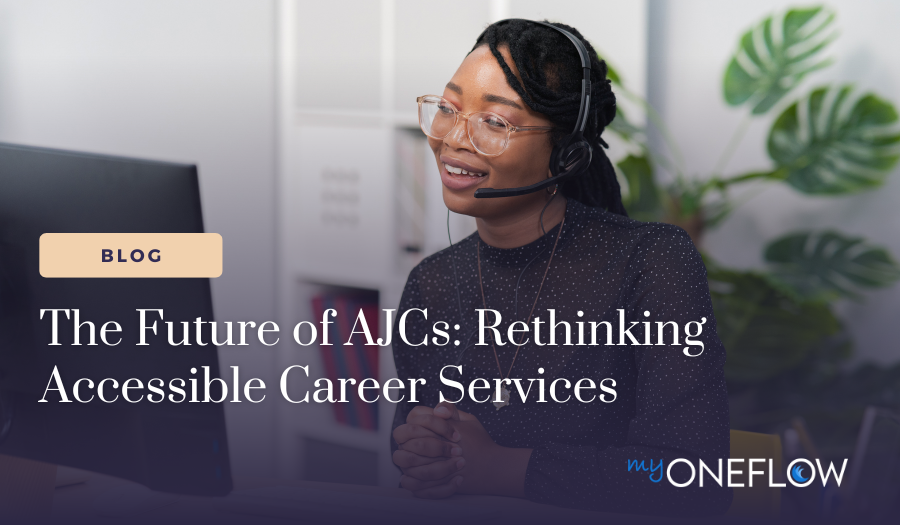4 Reasons to Embrace the Future of Public Service Delivery
Government social services are crucial in supporting individuals and families in need, providing resources and assistance to significantly improve...
5 min read
myOneFlow Staff Jun 27, 2024 10:30:14 AM

The rapid evolution of technology offers unprecedented opportunities to enhance the services provided by American Job Centers (AJCs). In this blog, we will explore various strategies to expand access points to AJC services physically and through technology. By examining successful implementations and proposing new integrations, we'll illustrate how AJCs can remain at the forefront of workforce development. From mobile AJCs to virtual assistants and integrated service delivery platforms, the path forward is rich with potential for transformation.
Our exploration will highlight the benefits of these advancements, such as increased accessibility for rural communities, streamlined service delivery, and enhanced engagement through modern technology.
By leveraging technological advancements and fostering strategic partnerships, American Job Centers can ensure they deliver comprehensive and accessible services to all citizens. This blog serves as a guide for policymakers, administrators, and stakeholders committed to redefining the landscape of workforce development in America.
Ensuring American Job Centers are fully accessible to all individuals requires innovative approaches beyond traditional service models.
Mobile AJCs represent a dynamic solution to increase accessibility, particularly in underserved areas. These mobile units can travel to various communities, eliminating the need for individuals to visit centralized locations. By bringing services directly to the people, mobile AJCs ensure that more individuals can access critical workforce development resources.
Food Banks and Childcare Services: Partnerships with local food banks and childcare services can create comprehensive support networks. Mobile AJCs can be stationed at these locations, offering a convenient one-stop solution for individuals seeking employment assistance while accessing other essential services.
Pop-Up Store Concepts: Adopting the pop-up store model allows AJCs to temporarily set up in high-traffic areas such as shopping centers or community events. This approach increases visibility and makes it easier for individuals to engage with AJC services during their daily routines.
Schools can serve as effective workforce hubs, particularly in communities where they are central gathering points. Using existing school facilities, AJCs can provide workshops, training sessions, and other services in familiar and accessible environments.
Buses and Public Transport: Integrating AJC services with existing transportation networks, such as buses, can further enhance accessibility. Mobile AJCs can be positioned at bus stops or along popular routes, making it easier for individuals, including parents, to access the needed services. This strategy is especially beneficial in rural areas, where transportation options may be limited, and distances to service centers are often greater.
Engaging Parents: By aligning service schedules with school bus routes, AJCs can effectively engage parents who may be dropping off or picking up their children. This creates an opportunity to reach out to individuals who might otherwise face barriers to accessing AJC services due to time constraints or lack of transportation.
Leveraging technology is crucial for modernizing American Job Centers and ensuring they are accessible to all individuals. This section explores how innovative technological solutions for workforce development can centralize resources, improve accessibility, and provide real-time service delivery.
Smartphone apps serve as centralized hubs where users can access various AJC services. These apps can include features such as document submission, appointment scheduling, and form completion. By consolidating these resources into a single platform, users can easily apply for needed services without visiting multiple websites or locations. This approach not only enhances accessibility but also streamlines the user experience, making it more efficient and user-friendly.
Virtual assistants can significantly enhance customer experience by providing real-time support and information. These AI-driven tools can answer frequently asked questions, assist with scheduling appointments, and guide users through various processes. By integrating virtual assistants into AJC services, users receive immediate assistance, reducing wait times and improving overall accessibility.
Mobile phone service delivery is an effective way to provide real-time access to AJC services. Users can receive updates, reminders, and notifications about job opportunities, training sessions, and other important events through text messaging and mobile apps. This method ensures that users stay informed and engaged, regardless of location. Additionally, mobile service delivery can facilitate two-way communication, allowing users to interact directly with case managers and other support staff.
Outsourcing specific tasks to tech companies can bring specialized expertise and efficiency to AJC operations. Tech companies can develop and maintain advanced platforms, ensuring they are secure, up-to-date, and user-friendly. By leveraging the skills and knowledge of these specialized firms, AJCs can focus on delivering high-quality services while benefiting from cutting-edge technology.
Virtual service delivery and real-time video conferencing are innovative solutions for enhancing case management. These tools enable case managers to provide personalized guidance and support remotely, breaking down geographical barriers. Users can participate in virtual coaching sessions, receive feedback on their resumes, and engage in mock interviews from the comfort of their homes. Real-time video conferencing allows face-to-face interactions, fostering a more personal connection between case managers and clients.
Effective policy and data-tracking frameworks are essential for maximizing the benefits of technological innovation in public service delivery. This section outlines key considerations for advocating, implementing, and monitoring these frameworks to enhance American Job Center services.
National platforms and standardized tasks offer significant cost savings and operational efficiency advantages. By advocating for a unified national framework, AJCs can leverage economies of scale, reducing administrative overhead and ensuring consistent service delivery across different regions. Standardization also facilitates easier integration of new technologies, streamlines staff training processes, and enhances the ability to measure performance uniformly.
Addressing the technology needs of AJC staff and users is crucial to fully realizing the potential of technological innovations. This begins with comprehensive education and training programs that equip staff with the necessary skills to utilize advanced tools effectively. Additionally, federal and state-level policy support can drive investment in infrastructure, ensuring that AJCs have access to the latest technologies and resources. Policies incentivizing continuous learning and professional development further ensure that staff can navigate evolving technological landscapes.
Due to limited internet connectivity, rural communities often face significant barriers to accessing AJC services. Overcoming these challenges requires targeted initiatives to expand satellite and broadband coverage. Federal and state governments can play a pivotal role by funding infrastructure projects to extend high-speed internet access to remote areas. Partnerships with private tech companies can also accelerate the deployment of these technologies, ensuring that rural populations receive equitable access to AJC services.
Robust data-gathering capabilities are critical for assessing the effectiveness of AJC services and tracking overall performance. Integrated case management systems enable real-time data sharing among agencies, providing caseworkers immediate access to up-to-date information. This transparency allows for more informed decision-making and better resource allocation. Furthermore, advanced analytics can identify trends, highlight areas for improvement, and demonstrate the impact of services on job seekers' outcomes. By emphasizing data-driven approaches, AJCs can continually refine their strategies to effectively meet their constituents' needs.
Designing accessible and mobile-centric American Job Center services necessitates a multifaceted approach that leverages technology, community partnerships, and innovative solutions. As we look to the future, continuous exploration and innovation will be vital in shaping the evolution of AJCs, making them more effective and adaptable. myOneFlow is the only case management solution designed to meet the complex needs of workforce development organizations and their partners. myOneFlow is a configurable, no-code platform that streamlines the application process while transforming data collection, simplifying required reporting, and securely connecting agencies and partners.
We encourage all stakeholders—governments, tech companies, and community organizations—to collaborate and drive advancements in service accessibility and mobility. By working together, we can create a more inclusive workforce development system that serves everyone, regardless of location or circumstances.

Government social services are crucial in supporting individuals and families in need, providing resources and assistance to significantly improve...

The Workforce Innovation and Opportunity Act (WIOA) was signed into law in 2014 to replace its predecessor, the Workforce Investment Act (WIA). The...

In an age of sleek software, automated processes, and personalized workflows, we expect a certain level of sophistication from our technology. We...